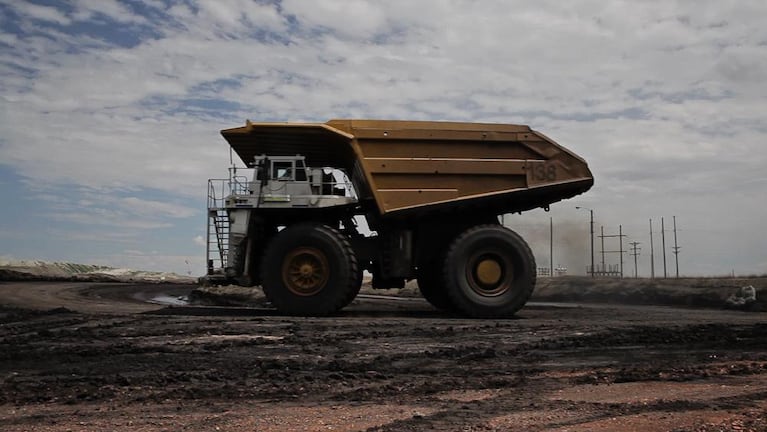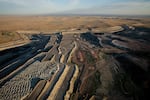
A senatorial investigation could shed new light on the ways companies influence the royalties they pay to extract coal from public lands.
Katie Campbell
One of Oregon Sen. Ron Wyden's first moves as chairman of the Senate Energy and Natural Resources Committee was to seek an investigation into the royalties taxpayers get back for coal mined on public land.
At issue: Are coal companies paying artificially low compensation to taxpayers for the coal they're extracting from public lands and sending to markets overseas?
Wyden sat down for an interview on the topic and said it comes down to two things:
“*"The first is, are taxpayers getting the full actual value for what is being extracted." *
"Issue two is, what are the implications of having this coal from federal lands being exported to Asia."”
Expect to hear more debate on this issue, as coal companies seek the permits they need to build proposed export terminals in the Northwest.
READ: Wyden Questions Whether Big Coal Is Fleecing Taxpayers
To break down these complex issues, here are 10 things you should know about the federal coal leasing program in the Powder River Basin:
1. The federal government controls the supply of coal
The Powder River Basin, in Wyoming and Montana, is the nation’s largest coal-producing region; it supplies about 40 percent of the coal produced in the U.S.
*_Watch video:_*
Almost all the coal in the region belongs to the federal government and is managed by the U.S. Bureau of Land Management. The U.S. Geological Survey estimates that there are still 127 billion short tons of accessible coal in the basin.
In effect, this gives the BLM a near monopoly over Western coal supplies.
2. Federal rules limit competition
Seven companies currently operate mines in the Powder River Basin, including the country’s three largest coal producers: Peabody Energy, Arch Coal, and Alpha Natural resources. Cloud Peak Energy is also a major player in the region.
Click on map for larger image.
The BLM offers a unit of coal for lease only if that coal will expand an existing coal mine and only after a company asks the BLM to make the coal available. That limits the possible bidders to companies already mining coal. And the BLM often limits the number of bidders to one.
Sometimes the coal up for lease is near two mines and attracts two bidders. Over the last five years, the BLM has finalized nine leases; auctions for six of them attracted only one bidder.
3. The BLM sets a minimum price
To secure a lease, companies offer bids of often hundreds of millions of dollars based on the amount of mineable coal they want. Even if only one company bids on the coal, that bidder has to meet or exceed a "fair market value" price set by the BLM. The BLM keeps that dollar figure secret. Winning bids become public information.
There is a 58-page manual that explains this process.
4. Companies that buy coal leases also pay rent and royalties
Coal companies pay royalties of 12.5 percent of revenues. The federal government gets 52 percent of the royalty payments; the rest goes to either the Wyoming or Montana state government.
Companies also pay a rental fee of at least $3 per acre.
A Recent Coal Lease
- 1 Bidder: BTU Western Resources, a Peabody Energy subsidiary
- Bid: $446,031,863.88 ($1.11 per mineable ton)
- Mineable coal: 401.83 million tons
- Rental: $3 per acre
- Royalty: 12.5 percent
5. Deductibles make a difference
Companies may shrink their royalty payments to taxpayers by deducting some expenses. Those deductions from their revenues are made before they calculate that 12.5-percent royalty. Companies may deduct the cost of washing the coal as they prepare it for market. They also may deduct the cost of transporting the coal to the buyer. That includes moving the product by truck, rail and ships.
These deductions can reduce royalties that must be paid to taxpayers by tens of thousands of dollars per trainload of coal.
6. Selling to a middleman could be keeping royalties low
The way royalties are determined depends on the how the coal changes hands. If the seller and the buyer are not affiliated with each other, the royalty payment is based on how much money the coal company makes when it sells the coal. If a mining company sells the coal to one of its own affiliates, royalties are based on a complex set of rules. The Office of Natural Resources Revenue is responsible for sorting out the business relationships and collecting the royalties.
Ron Wyden
A recent Reuters investigation alleges that companies like Peabody Energy and Cloud Peak Energy use trading affiliates to hide profits from overseas sales of Powder River Basin coal, to ensure they only pay royalties to the federal government based on lower U.S. sales prices. Coal companies say they're abiding by royalty rules.
Wyden says the investigation he and Sen. Lisa Murkowski, R-Alaska, are pushing for could determine whether it's really profitable to transport coal by train or barge through the Northwest and then ship it to Asia.
“"We'll see what this investigation says; possibly (that coal) would be exported to Asia through subsidies from U.S. taxpayers. We want to know if coal companies that reap profits from publically owned coal are paying enough in royalties." -- Sen. Ron Wyden, D-Ore.”
7. The feds are rewriting the royalty rules
In 2011, the Office of Natural Resources Revenue asked the public to help it formulate new ways to calculate royalties that would be fair to the public and less cumbersome for the agency and the coal companies. Comments from the coal industry are online.
8. Task Force taking a look
Last December, that same federal agency also formed a task force to audit certain coal companies and coal sales to overseas markets. The Office of Natural Resources Revenue collects coal royalties and is responsible for making sure coal companies are not cheating the public.
9. This isn’t the first time federal coal leasing has been investigated
In the 1980s, the U.S. General Accounting Office investigated coal leasing in the Powder River Basin and found that the federal government was miscalculating the fair market value of the coal and shortchanging the public. The GAO found that the government lost roughly $100 million by undervaluing coal leases.
10. Coal companies say they are playing by the rules
Arch Coal, one of the largest coal companies, said in a statement that in 2012, about 10 percent of its 2012 sales were exports, including 5 million tons of coal mined on federal land. Arch says it complies fully with royalty laws and is regularly audited by the federal government.
A spokeswoman for Peabody Energy also provided a statement: “Peabody believes the manner in which coal royalties are assessed is appropriate, and we remain compliant with those regulations.”
(Hover over markers to hear reports on coal in communities of the Northwest. Then click "website" for more EarthFix coverage. Click here for larger map view. Note: Train routes are approximations. They illustrate potential corridors based on existing lines and publicly available information.)




